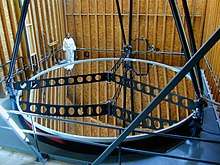Large Zenith Telescope
The Large Zenith Telescope (LZT) was a 6.0-meter diameter liquid-mirror telescope located in the University of British Columbia's Malcolm Knapp Research Forest, about 70 km (43 mi) east from Vancouver, British Columbia, Canada (north from Maple Ridge). It was one of the largest optical telescopes in the world, but still quite inexpensive. The telescope was completed in the spring of 2003 and decommissioned by 2019.
 The Large Zenith Telescope. Notice the size compared to the person at the back. | |
| Location(s) | British Columbia, Canada |
|---|---|
| Coordinates | 49°17′17″N 122°34′23″W |
| Altitude | 395 m (1,296 ft) |
| Built | –2003 |
| Telescope style | liquid-mirror telescope optical telescope Zenith telescope |
| Diameter | 6 m (19 ft 8 in) |
| Website | www |
 Location of Large Zenith Telescope | |
While a zenith telescope has the obvious disadvantage of not being able to look anywhere but at a small spot straight up, its simplified setup permits the use of a mirror consisting of a smoothly spinning pan filled with liquid mercury. Such a mirror can be made much larger than a conventional mirror, greatly increasing light collecting ability. The LZT is used for transit imaging, meaning that Earth's rotation moves stars along the sensor, and the latent image in the sensor is moved electronically in step with this movement and read out at the trailing edge.
The telescope made use of parts from the 3-meter diameter NASA Orbital Debris Observatory telescope, which had been using a liquid-mercury mirror for several years.
The Large Zenith Telescope is now decommissioned,[1] and all its liquid mercury stored for other projects.
This mirror was a test, built for $1 million, but it was not suitable for astronomy because of the test site's weather. The University plans a larger 8-meter liquid-mirror telescope named ALPACA for astronomical use at an estimated first-light cost of $5 million, $3 million contingency, $10 million for the camera, $5 million for a spectrograph, and $0.3 million operating costs per year.[2] A larger project is planned, called LAMA, with 66 individual 6.15-meter telescopes with a total collecting power equal to a 55-meter telescope, resolving power of a 70-meter scope.[3][4]
One article reported that it was decommissioned by 2019 at the latest, although it is not clear whether it was in routine operation for the entire time in between.[5] In 2016 it was noted as the third largest telescope in north America, and for its spinning mercury mirror that cost just 1% of normal mirrors, although it must view upward.[6]
See also

References
- Physics Footnotes: Liquid Mirror Telescopes.
- ALPACA overview.
- Hickson, P. and Lanzetta, K. M., 2004, July. Large aperture mirror array (LAMA): project overview. In Second Backaskog Workshop on Extremely Large Telescopes (Vol. 5382, pp. 115–126). International Society for Optics and Photonics.
- The University of British-Columbia Liquid-Mirror Observatory - Perfecting the next generation of super telescopes.
- Clery, Daniel (2019-07-18). "Could humanity's return to the moon spark a new age of lunar telescopes?". Science – AAAS. Retrieved 2019-10-09.
- "World's Largest Liquid Mirror: Large Zenith Telescope". interestingengineering.com. 2016-05-06. Retrieved 2019-10-09.